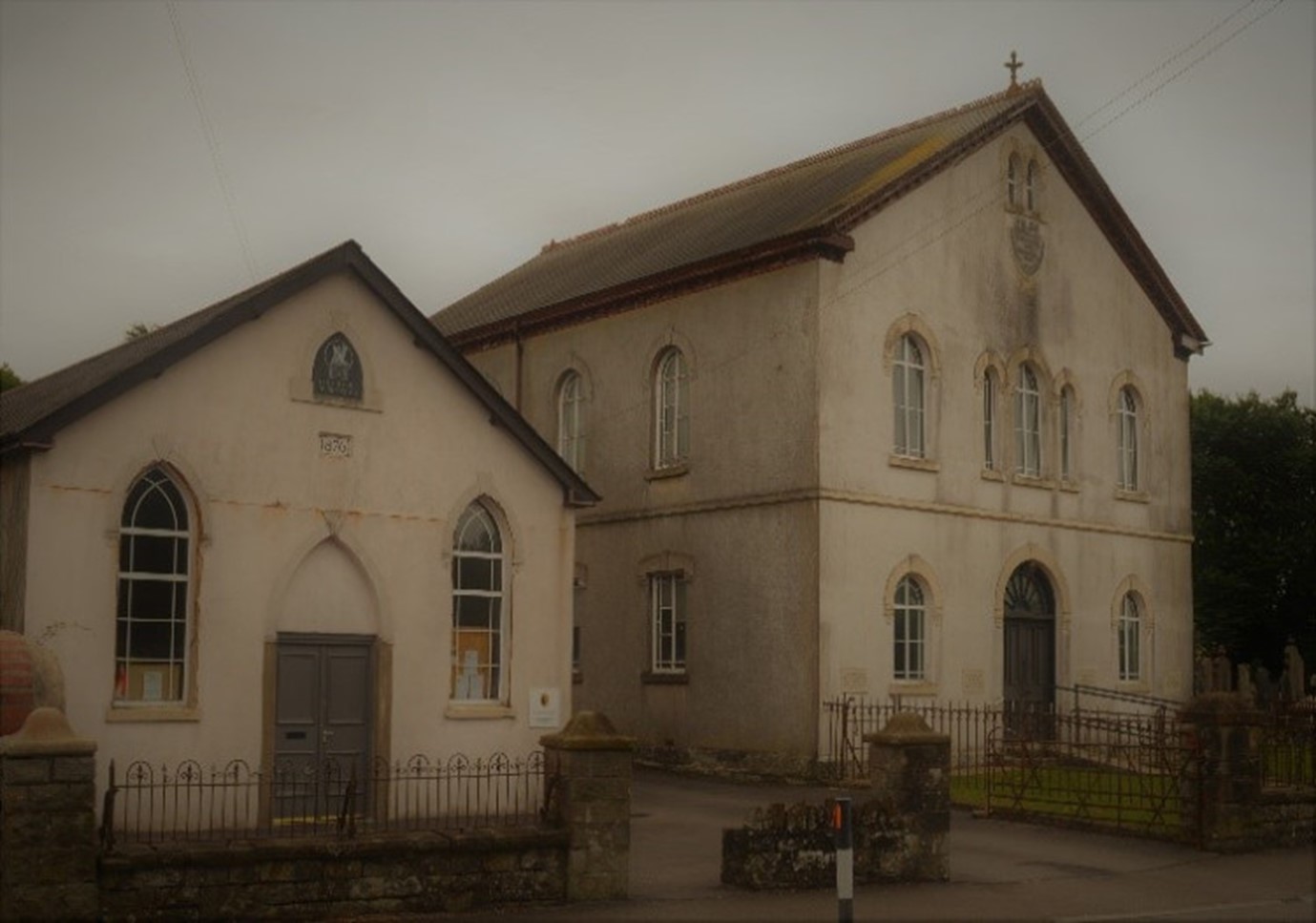History
History
FIRST SCHOOLS TO FARMING
Religious persecution and the reformation of churches meant that learned priests had more time on their hand and to supplement their income they established a number of small schools.
During the 17th and 18th century, as more priests lost their churches they turned to opening simple schools as an additional source of income. This was also a time of religious revival and in LLangan, David Jones, one of Wales’ most famous preachers became its rector. There were other famous residents, including the architect John Pritchard who was responsible for the renovation of LLandaff Cathedral. As the needs for travelling increased, roads had to be improved and this led to the establishment of Turnpikes. One Of Treoes most famous families is the Mordecai family, but who were they and where did they come from? Treoes at this time remained a rural area and farming was still the main occupation.
This section is divided as follows:
First Schools – with the first school in the area being established at LLangan
David Jones – the Angel of LLangan, who drew crowds of hundreds to hear him preach
John Pritchard – the influential neo-gothic architect who built and renovated many famous building in South Wales
Turnpike Roads – the increase in travel and stagecoach led to new charges
The Mordecai Family – a brief history of this family who are closely associated with Treoes
Farming – the life and strife of the yeomen of Treoes.
FIRST SCHOOLS
Religious persecution and the reformation of churches meant that learned priests had more time on their hand and to supplement their income they established a number of small schools.
Because of his opposition to church reforms he also lost his parish between 1646 and 1650, although he continued to receive some tithes paid to him. To supplement his meagre income he established a small school in Llangan. Later he moved to London to become Chaplain to the Royalist Earl of Peterborough. Francis Davies later returned to Wales to become Archdeacon of Llandaff Cathedral in 1660 and Bishop of LLandaff in 1667.
In 1876 A board school was erected in St Mary Hill for 70 children, although the average attendance was just 44. Mrs Emma Evans was the original Schoolmistress. The Schoolmistress in 1906 was Miss Elizabeth Tamblyn.


The Welsh Not was a piece of wood inscribed with the initials WN to be hung around the neck of pupils who had spoken Welsh, so as to dissuade the use of the Welsh language during the school day.
DAVID JONES
The parish of LLangan is closely associated with David Jones – its rector for 43 years, from 1767 until his death in 1810.
David was born in 1736 to a farming family in Carmarthenshire. David’s parents were very religious and their wish was that their eldest son would enter the ministry whilst David, as the second eldest, would help on the farm. But fate took a hand when the young David fell into a vat of boiling milk. He was very badly burned and nearly died.
David could no longer do heavy work – so the roles were reversed and his elder brother became the farmer whilst David went into the church.

David Jones’s birthplace in Carmarthenshire,
Source Well digger website
David’s parents did not have enough money to send him to university, but he got into Carmarthen Grammar School and studied hard, becoming a Deacon by the time he was 22. He then served as a Curate, firstly in North Wales, then Brecon later at Caldicot in Monmouth.
It was during David’s time at Monmouth that he was heavily influenced by William Read of Trefethin who introduced him to the writing of Puritans such as John Flavel. This gave David a deeper and more personal understanding of the Gospels and changed David’s style of preaching from one of explaining text in the bible to an impassioned anointing of the Holy Spirit.

At this time LLangan was a spiritual backwater with a population of no more than 300. Within a few years though – such was the power of David’s evangelical preaching – that crowds of thousands of people would come from all over Glamorgan to hear him preach.
Often David would address them through a window, or on the steps of the medieval pillar cross in the grounds of the church.
David was 45 when he married Sinah Bowen in 1771; they lived in the rectory at Coychurch and had three children: Maria, Daniel and David Bowen. Sarah died in 1792, aged 60. David later remarried and lived at Manorowen.
David also preached at local fairs and other gatherings, where there was a high incident of drunkenness and fighting. This included the annual horse fair at St Mary’s Hill where he converted a great number of people
David was an enigma – he was a rector in an Anglican Church who was a revivalist and a passionate preacher with a leaning towards Methodism. David started to arrange home meetings in nearby farms. By 1775 the demand for these meetings was so great that David was compelled to raise the sum of £282 to build Salem Chapel in Pencoed. Salem became the focal point for Methodism in the Vale.
David was passionate about preventing the church from dividing into factions, but despite all his efforts the Methodist movement split from the Anglican church a year before David’s death in 1810.


Portrait of David Jones, the Angel of LLangan.
David was a man of God and a man of peace, He spoke from the heart and his importance in the religious and spiritual life of Wales cannot be countered.
His preaching took him to all corners of Wales and to many English cities where people would walk or ride from miles to hear his voice.
Little wonder that he was known as the “Angel of LLangan”.
David’s influence on the church did not end there as his great- grandson Llewellyn Llewellyn became the first Dean of St. David’s Cathedral in 1840.
William Williams (Williams Pantycelyn) sang about Jones Llangan:-
“The stones melted with his freshness and in the strength of his sweet gospel he made the most hardened oak bend flexibly like the rushes”.
JOHN PRITCHARD
John Prichard was a well-known and highly respected architect who had a reputation for building and restoring in the neo-Gothic style.
Arguably, his most famous achievement was the restoration of Llandaff Cathedral, but he was also responsible for the design and restoration of several other notable buildings, bridges and churches in south Wales.

Collena House, Tonyrefail
John Prichard was born in Llangan on the 6 May 1817. He was the twelfth son of the rector Richard Prichard, the vicar-choral of Llandaff, where he served for 35 years. They were descended from the Prichard family of Collenna, a substantial estate in near Tonyrefail.
Prichard trained as an architect under Thomas Larkins Walker, who in turn was deeply influenced by the neo-Gothic style of Augustus Pugin.
John Pritchard made a good business decision when he established a practice in Llandaff, Cardiff because this eventually resulted in becoming the official diocesan architect in 1847. Much of John Pritchard’s work as an architect was done in collaboration with John Seddon.
A great deal of John Pritchard’s major commissions were restoration works the most famous of which would be that of Llandaff Cathedral between 1843–69. This included the full restoration of the south-western tower. A substantial part of the work was however destroyed by bombing during the Second World War.
The Prichard Bridge, built in 1880 to allow carriages to cross the feeder channel between the River Taff and the Llandaff corn mill, was named after the architect and is now a Grade II listed building. The mill was demolished in the 1930s, the feeder stream has long ceased to exist and the lower part of the bridge is no longer visible.
Prichard and Seddon also worked on the restoration of Ettington Park, where John Prichard’s brother Richard was the vicar. John Prichard also designed Nazareth House, a Catholic alms house built on land donated by John Crichton-Stuart, 3rd Marquess of Bute.
Prichard died, unmarried and childless, at the age of 69, and is buried on the south side of the cathedral.
On Prichard’s death Seddon succeeded him as diocesan architect.

John Pritchard’s grave, LLandaf Cathedral
A List of the buildings that John Pritchard was responsible for include:
- Llandaff (1843–1869) restoration
- Prichard Bridge, Llandaff (c.18
- Nazareth House, Cardiff (1875)
- St Cadfan’s Church, Tywyn (1877) restoration
- Church of St Swithin, Ganarew (1850)
- Church of the Holy Cross, Cowbridge (1850–1852) restoration
- St Michael’s Church, Cwmafan (1851).
- The Church of St Julius and Aaron, Llanharan (1856–1859) restoration
- Ettington Park, near Stratford upon Avon (1858–1862) restoration.
- Church of St John, Llandenny (1860-5) with John Pollard Seddo
- St Margaret’s Church, Roath (1870) commissioned by the Marquess of Bute
- St Crallo, Coychurch (1871) restoration
- Church of SS. Illtyd, Gwynno & Tyfodwg, Llantrisant (1874) restoration
- St Catharine’s Church, Baglan (1875–1882) restoration
- Church of St Thomas a Becket, Monmouth (1876)
- St Mary’s Nolton, Bridgend (completed 1877) build.
- St Mary’s on Chapel Hill, Tintern, Monmouthshire (1863–1868) restoration.
- Elerch Vicarage
TURNPIKE ROADS
As trade and travel increased it became more important to keep roads open and in good condition.
It was in 1764 that the first Turnpike Act affecting Glamorgan was passed, the original act having been passed nationally in 1663. Prior to this Act every Parish was legally obliged to look after its roads, which were generally no more than dirt tracks.
The men of the Parish were expected to give six days free labour each year to maintain them. Needless to say the maintenance was not very effective, as those having to do the work rarely benefitted from it.
The Toll Roads were run by Trusts. Trustees would be people with personal wealth, they would arrange for siting of the Turnpike gates and the collection of the Tolls. The monies collected would be shared amongst the Trustees and spent maintaining the roads.

Sketch of an 18th century turnpike road
The Turnpike in Treoes was situated on the Treoes to Llangan road, just past the entrance to Yr Efail.
MORDECAI FAMILY
The Mordecai family have been associated with Treoes for many years, but where did they come from and what was their background?
It was possibly the woollen industry that first brought the Mordecai family to Treoes. The earliest record is of an Edward Mordecai (Genealogy website mytree.net) who was born in LLangan in 1751, When he was just 15 years old Edward married Gwenllian (John) Popkin, 11 years his senior in 1766. They had four children: Thomas born in 1771, Mary born in 1776, Edward born in 1778 and William born in 1781. There is no explanation of the use of the name John by Gwenllian, it could be possible that she had been married before marrying Edward Mordecai, or that she was given the Christian names of Gwenllian John.
Gwenllian came from an ancient Welsh family, reputed to be descended from Rhodri Mawr. Her father was Sir. Esq. Thomas Popkin born 1695 in Forrest in the Parish of Llansamlet. He owned an Ironworks in Llansamlet and also had a lease of coal mines in Lougher.
The following is an extract from The History and Antiquities of Glamorganshire and its Families:–
“There were Popkins of Ynys Tawe and Forrest, both of the same lineage, the former, the senior line and both now extinct. They claimed descent from Rhodri Mawr King of Wales, through his eldest son Prince Anarawd (succ.AD877) Gruffydd Gethin, the first named in the pedigrees as an Ynys Tawe, ninth in descent, had a son Hopkin ap Gruffydd, and he a son David ap Hopkin of Ynys Tawe, who married Eva daughter of Jenkin ap Leyshon of Avan, of the race of Iestyn ap Gwrant. Hopkin ap David ap Hopkin followed, and had a son David ap Hopkin whose son Hopkin David of Ynys Tawe had an eldest son: David Popkin, who finally fixed the patronymic as a surname. He married Jennet daughter of Robert William of Court Rhyd-hir, and with other children, had a son and successor John, second son of ………”
The Forrest junior line begins with Hopkin, second son of the above Hopkin David of Ynys Tawe and continues at Forrest near Neath for ten generations. This line seems to have held a higher position in the county than the senior. Thomas Popkin of Fforrest was Sheriff of Glamorgan in 1718 and his son Thomas held the same office in 1755.
Tracing Edward Mordecai’s ancestry is not easy. There is a record of an Edward Mordecai who died in Llansamlet in May 1715. His son, William Mordecai, was born also in Llansamlet a year earlier, in 1714. Could the Edward Mordecai born in Llangan in 1751 be their descendant?. There is a possible connection here, as Gwenllian’s family also originated in LLansamlet.
The name Mordecai appears to have Jewish origins and during periods of anti-Semitism, family members could have used the alias of Mort or Morton or Moreton. There are local records of Mordecai being used as an alias. For example, in mytree.net,, we have a reference to Mary Mort alias Mordecai. Other references to the name of Mort in the Parish are contained in St Canna’s parish records between 1836 and 1847 and of Moreton in 1887.
The Family Tree shows the death of Edward Mordecai as Feb 1782, whilst significantly St Canna’s Parish records show both Edward (buried 7th Feb 1782) in the name of Mort and Gwenllian (buried in 1815) with the name of Mort and the alias of John.
Another significant use of the name Mort is the name change of David Mordecai, born in Margam and married to Ann nee Llewellyn, who changed their name from Mordecai to Mort in 1871. Their son Thomas Mort migrated to the Ukraine, where he married Rachel Thomas and had six children. He returned briefly in 1905 before emigrating to the United States of America.
It does not take a far stretch of the imagination to associate the Mordecai family with Gwenllian Walsh and Watcyn or Watkin Morton who lived in Goston in the 14th century and their possible descent from Rhodri Mawr via Princess Nest as well as the claimed descent from Rhodri Mawr via Gwenllian Popkin.
The following is a contract drawn up between Thomas Mordecai, Edward Mordecai and William Mordecai to maintain Gwenllian their mother. (From the Glamorgan Archives)
“Be it remembered that it is contracted this 19th day of April 1809 & between Morgan Philip, Churchwarden & Tho’s David Overseer of the Poor of Llangan, & of the one part. And Thomas Mordecai, and Edward Mordecai, Weavers of the Parish of Llangan and William Mordecai Weaver of the Parish of St Mary on the other part, do hereby agree to maintain Gwenllian John a parishioner of the above said Parish of Llangan, at our proper cost and charges, find and Provide and allow, our cause to be found whatever necessary to her the said above named Gwenllian John their mother – now chargeable to the above named Parish. They the sons Thos. & Edwd. Mordecai, and Wilm. Mordecai, being to pay thus Thos. Mordecai is to pay one half and Edwd. Mordecai is to pay one Third and Wilm. Mordecai is to pay one Third unto the Overseers hands or cause to be paid whatever sum or sums that shall be wanted for her necessary relief- likewise Morgan Philip the Churchwarden and Thos. David the Overseer of the Poor allow her sixpence weekly towards Gwenllian John’s relief and also allow her sixpence towards John Thomas’s lodgings, and the house is to be jointly occupied by both of them. Signed in the presence of Edmund Jenkins, Thomas Mordecai the mark of Edward Mordecai, Rees Jones, William Mordecai.”
As Thomas Mordecai, Gwenllian’s son had married Catherine Thomas it is possible that John Thomas Gwenllian’s lodger was Catherine’s father.
Descendants of Edward and Gwenllian and their son Thomas who are still residents of Treoes, as are the Mordecai family of Ty-Phillip and the family of the late John Richards son of Ivor Richards and Alice Mordecai, late of Great House.
Descendants of Edward and Gwenllian and their son Edward who are still residents of Treoes are the Jenkins family, by way of the marriage of Cecilia Mordecai (granddaughter of Edward) to Evan Jenkins and their son George Miles Jenkins.
FARMING
Most people still lived off the land for most of the 19th century, as villages and industry grew, it was becoming more difficult to find agricultural labour.
On nearly every farm wheat and barley was produced, and we can safely assume that this was so in Treoes due to the presence of the Malt House adjoining the Star Inn.
Farmers would have grown oats for animal feed, but due to the importation of cheap corn from the United States the farmers were forced to turn their attention to milk production, and sheep farming.
We can picture the ride to market day in Cowbridge, the farmers riding their shire horses with their wives seated behind carrying large baskets of produce for sale, meeting pack-mules of the coal merchants carrying coal to Cowbridge and the villages (D J Francis).

The remains of Candy Mill



